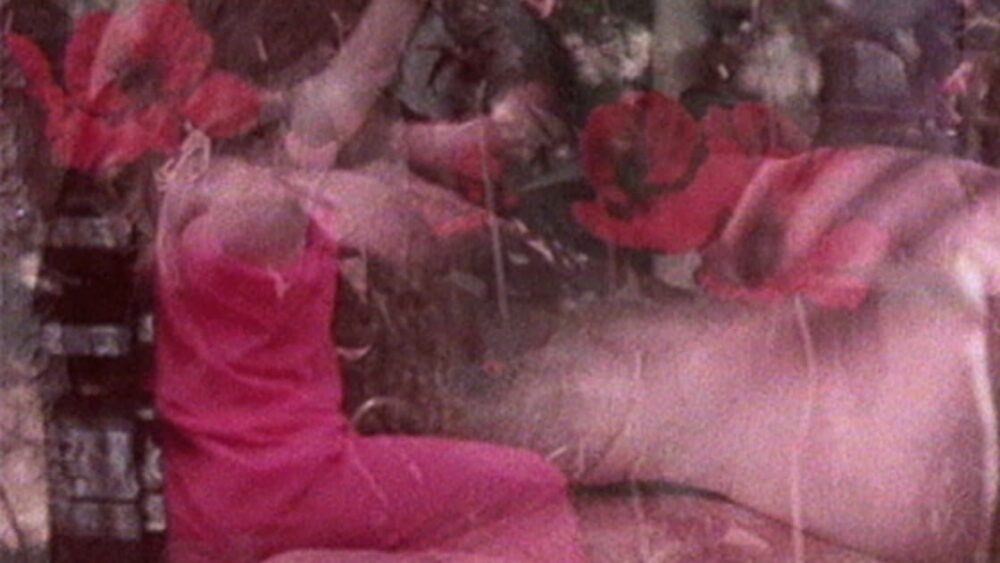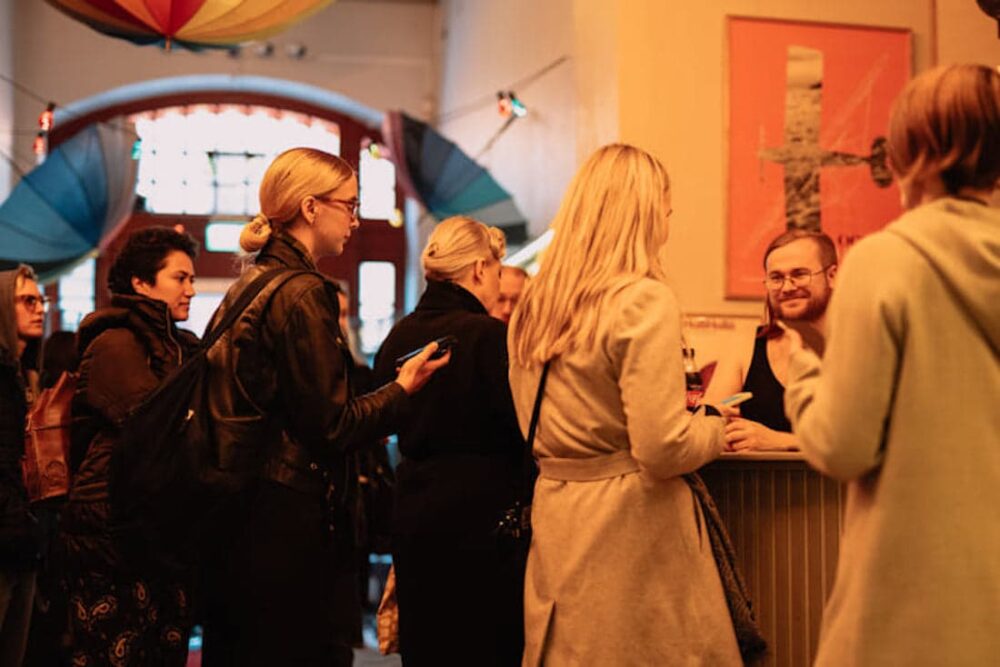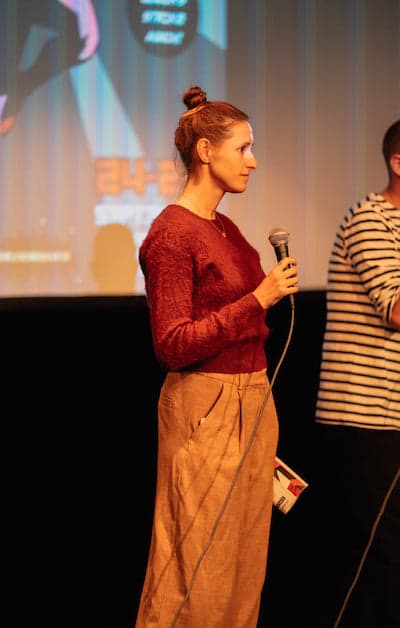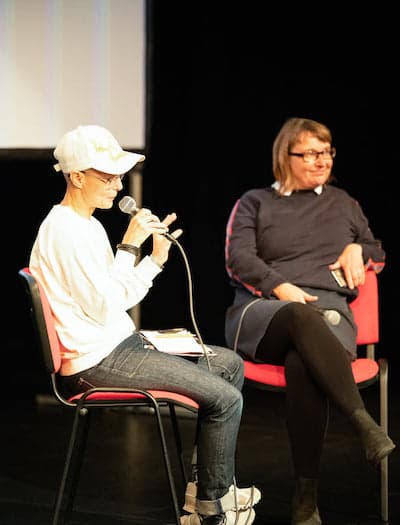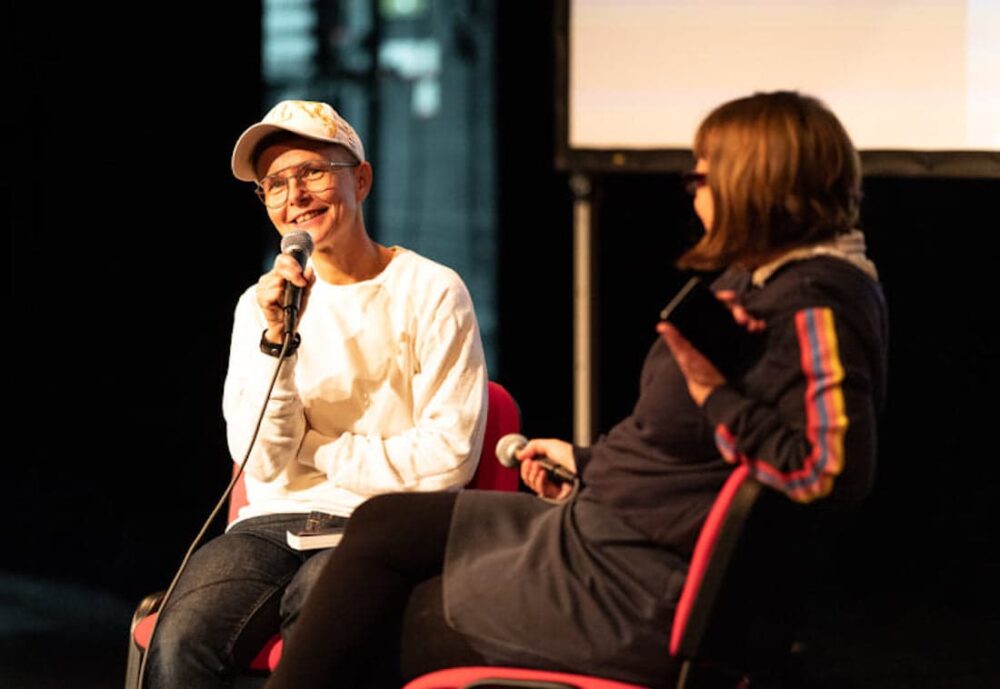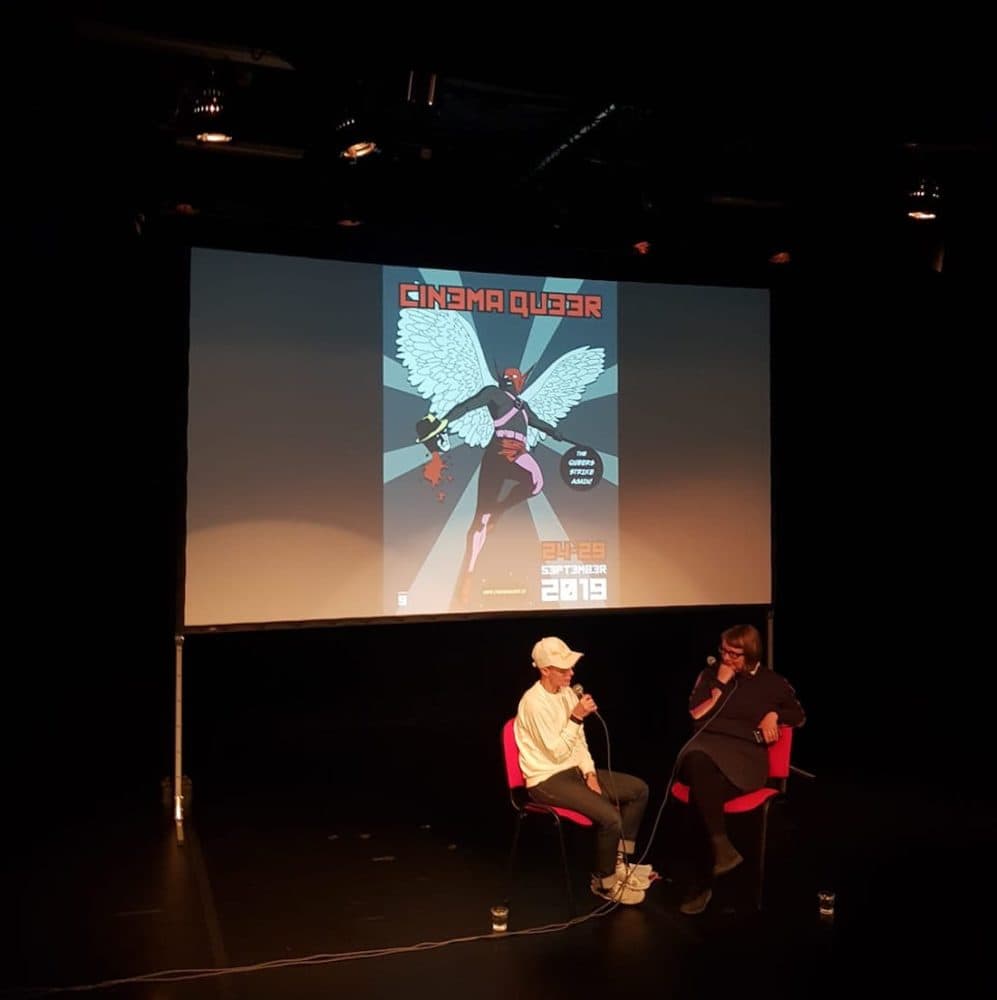In memory of Barbara Hammer (1939-2019)
Date
2019-09-27 18:00 – 2019-09-28 14:00
Location
2019-09-27
Svenska längre ned
CINEMA QUEER 2019 – BARBARA HAMMER RETROSPECTIVE IN TWO PARTS
Friday September 27th at 18.00 – Cinemateque Stockholm
Saturday September 28th at 14.00 – Teater 3 Stockholm
One of the most significant players within queer film, experimental film – well, film – left the stage this year. Barbara Hammer passed away earlier this year.
Hammer’s films include everything from intense agitation to dripping irony. In them Hammer explores moving images and the politics of representation. From Hammer’s extensive work we will screen a selection of films that make up an overview of how she obliterated borders, shattered norms, and responded to the art film world’s stereotypical representation of minorities, with images that reverberate with power, joy, sorrow, anger, and reflection. The program is curated by Anna Linder from SAQMI – The Swedish Archive for Queer Moving Images, and is screened in collaboration with Cinemateket.
⭕️ The films are divided into two programs: “The Politics of Abstraction” and “Sister Lessons no.1”. The first program takes place at Cinemateket Friday Sept 27 18:00, and the second at Teater Tre Saturday Sept 28 14:00.
? Film programme 1: The Politics of Abstraction
The title of this program “The Politics of Abstraction”, is borrowed from Barbara Hammer’s biography “HAMMER! Making Movies out of sex and life”, and gives us access to Hammer’s experimental lesbian film world.
➖ I Was/I Am (USA, 1973, 6 min)
➖ Sync Touch (USA, 1981, 10 min)
➖ Optic Nerve (USA, 1985, 17 min)
➖ No No Nooky T.V. (USA, 1987, 12 min)
➖ Dyketactics (USA, 1974, 4 min)
➖ Pond and Waterfall (USA, 1982, 15 min)
Tickets and more information:
Cinemateket Stockholm Friday 27th September 2019 at 18.00.
? Film programme 2: Sister Lessons no.1
This program is inspired by Barbara Hammer’s film History Lessons from the year 2000. As a feminist maker and storyteller and with her enormous curiosity, Barbara Hammer often embarked on an archival journey. In this program, Hammer lets us meet artist Claude Cahun and the diving women from Jeju-do. Recurring in Hammer’s huge production are the personal portraits and the search for like-minded people.
➖ Diving Women of Jeju-do (USA, 2007, 24 min)
➖ Lover/Other (USA, 2006, 55 min)
After the films at Teater Tre on day two, Anna Linder (curator) and Dagmar Brunow (film scholar) will talk about Hammer’s work.
More info on our website:
www.cinemaqueer.se
CINEMA QUEER – BARBARA HAMMER RETROSPEKTIV I TVÅ DELAR
När Barbara Hammer gick bort tidigare i år lämnade en av queerfilmens, experimentfilmens – ja, filmens – mest betydelsefulla utövare scenen.
Hennes filmer rymmer allt från intensiv agitation till dräpande ironi och i dem undersöker Hammer filmbilden och dess representationspolitik. Ur Hammers digra produktion visar vi ett urval filmer som tillsammans ger en överblick av hur hon sprängde gränser, bröt normer och svarade på filmkonstens stereotypa representationer av minoriteter, med bilder som sjuder av kraft, glädje, sorg, ilska och eftertanke. Programmet är curerat av Anna Linder från SAQMI – The Swedish Archive for Queer Moving Images – och visas i samarbete med Cinemateket.
⭕️ Filmerna är uppdelade i två program: “The Politics of Abstraction” och “Sister Lessons nr. 1”. Första programmet är på Cinemateket fredag 27 sept kl.18, och det andra på Teater Tre lördag 28 sept kl.14.
? Filmprogram 1: The Politics of Abstraction
Titeln, som är hämtad ur Barbara Hammers biografi HAMMER! Making Movies out of sex and life, ger oss en ingång till Barbara Hammers experimentella lesbiska bildvärld.
➖ I Was/I Am (USA, 1973, 6 min)
➖ Sync Touch (USA, 1981, 10 min)
➖ Optic Nerve (USA, 1985, 17 min)
➖ No No Nooky T.V. (USA, 1987, 12 min)
➖ Dyketactics (USA, 1974, 4 min)
➖ Pond and Waterfall (USA, 1982, 15 min)
Tickets and more information:
Cinemateket Stockholm Friday 27th September 2019 at 18.00.
? Filmprogram 2: Sister Lessons nr.1
Detta program är inspirerat av Barbara Hammers film History Lessons från år 2000. Som en feministisk markör, historieberättare och med sin enorma nyfikenhet ger sig Barbara Hammer ofta ut på en arkivarisk resa. I detta program låter Hammer oss möta konstnären Claude Cahun och de dykande kvinnorna från Jeju-do. Återkommande i Hammers enorma produktion är de personliga porträtten och sökandet efter likasinnade.
➖ Diving Women of Jeju-do (USA, 2007, 24 min)
➖ Lover/Other (USA, 2006, 55 min)
Efter filmerna på Teater Tre dag två, samtalar Anna Linder (curator) och Dagmar Brunow (filmvetare) om Hammers livsgärning.
Mer info och biljetter på vår hemsida
Nedan följer filmtexter och programtexter i sin helhet (a mix of English and Swedish):
Ett hyllningsprogram till BARBARA HAMMER (1939-2019)
Svenska längre ned
Film programme 1: The Politics of Abstraction
With a career spanning fifty years, Barbara Hammer is recognized as a pioneer of queer cinema. A visual artist working primarily in film and video, Hammer created a groundbreaking body of experimental work that illuminates lesbian histories, lives and representations. Stated Hammer, “My work makes these invisible bodies and histories visible. As a lesbian artist, I found little existing representation, so I put lesbian life on this blank screen, leaving a cultural record for future generations.”
Barbara Hammer was born in 1939 in Hollywood, California. She lived and worked in New York until her death in 2019.
The title here comes form Barbara Hammer’s biography HAMMER! Making Movies out of sex and life gives us an insight into Hammer’s experimental lesbian world. As Hammer says herself in the book, “As an experimental filmmaker and a lesbian feminist, I have advocated that radical content deserves radical form. To the feminist community, I introduced my films in light of the formal concerns of experimental filmmaking. To the experimental film community, I spoke about the importance of unrepresented content.” In this programme, developed specifically as a tribute to Hammer’s suggestive way of life, we are able to trace all the way from the very first 16mm film I Was / I Am, right up until the end of the eighties and the influence of computer language in No No Nooky T.V. / Anna Linder
I Was/I Am
1973, 5:44 min, b&w, sound, 16 mm film
The Films of Maya Deren (1917-1961) opened a door for me as a young artist. I referenced her film Meshes of the Afternoon (1945) in my first 16 mm film. I transition from a princess with a white gown and tiara into a motorcycle dyke wearing leather. Screened on the opening night at Hammer retrospective at The Museum of Modern Art New York in 2010.
Sync Touch
1981, 10:07 min, color, sound
“A lesbian/feminist aesthetic proposing the connection between touch and sight to be the basis for a ‘new cinema.’ The film explores the tactile child nature within the adult woman filmmaker, the connection between sexuality and filmmaking, and the scientific analysis of the sense of touch.” — Barbara Hammer
“At the opening we are listening to an ‘expert’ speaking – someone who knows about touch and erogenous zones, about the erotic – yet the emphasis is on her ‘knowing’ and what she knows ‘about’ rather than on her ‘experiencing.’ Hammer undercuts the monologue with intense and extraordinary close-ups of areas of the woman’s face and neck, her teeth and lips, her ears. The viewer becomes so absorbed in the details of this closeness, the closeness of a lover seeing the face of her friend, that the words become lost in feeling and experiencing the closeness itself. The other way this works is to make the viewer want to touch, to become involved for, as the speaker says, touch precedes sight in the new-born child, and sight becomes a connection between the actual touch and understanding what it means.” — Cath Dunsford, Alternative Cinema
Optic Nerve
1985, 16:43 min, color, sound
“Barbara Hammer’s Optic Nerve is a powerful personal reflection on family and aging. Hammer employs filmed footage which, through optical printing and editing, is layered and manipulated to create a compelling meditation on her visit to her grandmother in a nursing home. The sense of sight becomes a constantly evolving process of re-seeing images retrieved from the past and fused into the eternal present of the projected image. Hammer has lent a new voice to the long tradition of personal meditation in the avant-garde of the American independent cinema.” — John Hanhardt, Biennial Exhibition Catalogue, Whitney Museum of American Art, New York, 1987
No No Nooky T.V.
1987, 11:52 min, color, sound, 16 mm film on HD video
Using a 16mm Bolex and Amiga computer, Hammer creates a witty and stunning film about how women view their sexuality versus the way male images of women and sex are perceived. The impact of technology on sexuality and emotion and the sensual self is explored through computer language juxtaposed with everyday colloquial language of sex. No No Nooky T.V. confronts the feminist controversy around sexuality with electronic language, pixels and interface. Even the monitor is eroticized in this film/video hybrid that pokes fun at romance, sexuality, and love in our post-industrial age.
Dyketactics
1974, 4:00 min, b&w and color, sound, 16 mm film on video
“A popular lesbian ‘commercial,’ 110 images of sensual touching montages in A, B, C, D rolls of ‘kinaesthetic’ editing.” — Barbara Hammer
“Hammer’s films of the ’70’s are the first made by an openly lesbian American filmmaker to explore lesbian identity, desire and sexuality though avant-garde strategies. Merging the physicality of the female body with that of the film medium, Hammer’s films remain memorable for their pioneering articulation of a lesbian aesthetic.” – Jenni Sorkin, WACK! Art and The Feminist Revolution, 2007.
Pond and Waterfall
1982, 15 min, color, silent, 16 mm film on video
“Hiking in Point Reyes National Seashore I came upon a vernal pool with an intriguing and mysterious underwater world. I optically printed swimming underwater to slow the movement to a meditative rhythm. I hoped that the appreciation of the clarity and beauty of water would lead us to better protect it.” — Barbara Hammer
“The camera eye is like an amphibian that sees on two levels in its journey from underwater in a safe pond down to a violent, turbulent ocean. Early in the silent film shot north of San Francisco we see an homage to Monet’s Nymphiades in the faded raspberry color of the step-printed underwater lilies. The painterly effects of the printing make the water seem viscous. Pushing through clouds of fish eggs, fronds and algae, the camera establishes a sense of intimacy and connection in a natural ecosystem. But this amiable underwaterscape acquires ominous overtones as the camera/amphibian surfaces. Splashes strike the lens, and the rock of the ocean surf is destabilizing and disorienting. One of the most provocative foreshadowing ambiguities occurs when the half-submerged camera tracks the tip and slosh of the horizon, echoing the mood change from underwater confidence to vulnerability to natural forces, a passage from balance to defiance.” — Kathleen Hulser, “Frames of Passage: Nine Recent Films of Barbara Hammer,” Centre Georges Pompidou
Filmprogram 2: Sister Lessons No.1
The title is inspired by Barbara Hammer’s 2000 film ‘History Lessons’. As a feminist marker and storyteller, and with her enormous curiosity, Hammer’s process is often an archival journey. Whether in reference to someone who has long passed away or to a living and breathing contemporary, Hammer talks about her fellow sisters’ feminist and queer struggles. Here her style is as frenetic as always, with as much energy and with perpetual curiosity about other people and their environments. In this programme Hammer shows us her meetings with some islanders, including artist Claube Cahun and ‘the driving women’ from Jeju-do. Recurring Hammer’s enormous production is both the personal portraits of people she meets and her search for like-minded people. This is especially apparant in films Hammer produced after ‘History Lessons’, where she delved into films about and with other people like Maya Deren, Elizabeth Bishop and others. / Anna Linder
“Diving Women of Jeju-do (USA, 2007, 24 min)
Jeju-do is the largest of Korean islands and lies between Korea and Japan. There, for hundreds of years, women dive without breathing apparatus to the ocean floor and collect shellfish, octopus, and urchins that they sell. This ancient women’s tradition is about to die. Barbara Hammer dives with the women and records the reasons behind their disappearing work and lifestyles.
Driver/Second Camera: Min Tae-Ryun. Translators: Grace Lee, Sook-Hee Kim. Composers: Jeeyoung Kim, Gerhard Stabler. Jeju Folk Songs: “Ahwehgi,” “You and Me,” “Sounds of Waiting.” Sound Mix: Stephanie Testa. Research: Rim Hwa Han, Josephine Wright. Archives: Ms. Ryan, The AMA Diver, Jeju Hae-Nyeo. Funding: N.Y. State Council for the Arts, The Experimental T.V. Center, Women’s Film Festival in Seoul.Director/Camera/Editing: Barbara Hammer. Assistant Director: Myung Mi Ha.
Lover/Other (USA, 2006, 55 min)
1920s Surrealist artists Claude Cahun and Marcel Moore come to life in this hybrid documentary. Lesbians and step-sisters, the gender-bending artists lived and worked together all their lives. Heroic resisters to the Nazis occupying Jersey Isle during WWII, they were captured and sentenced to death. Hammer infuses this film with vigor, using photographs, archival footage, dramatic interludes of a “found Cahun script,” and unique interviews with Jersey Isle residents who knew the “sisters.”
Sound Design: Pamela Z. Actors: Kathleen Chalfant, Marty Pottenger, Alana Chazan, Yves Musard. Costumes: Alicia Relles, Eva Saks. Make-Up: Jerry Lopez. Sound Mix: Paul Hill. Production Assitants: Sam Feder, Kalip Linzy, Sean Solowiej, Stephanie Testa, Christina Wall. Archives: Jersey Film Archive, Olive Thompson Film, Jersey Heritage Trust, Jersey War Tunnels, Société Jersiasise, San Francisco Museum of Modern Art. Funding and Support, New York State Council on the Arts, Women In Film, Experimental T.V. Center, Wexner, Center Media Arts Program, The Ohio State University, The Hugh M.Hefner Foundation.
Curator Anna Linder
SAQMI – The Swedish Archive for Queer Moving Images in collaboration with Cinema Queer and The Cinemateque Stockholm.
Filmprogram 1: Abstraktionens Politik
Titeln som är hämtad ur Barbara Hammers biografi HAMMER! Making Movies out of sex and life ger oss en ingång till Barbara Hammers experimentella lesbiska bildvärld. Som Hammer själv säger i boken ”As an experimental filmmaker and a lesbian feminist, I have advocated that radical content deserves radical form. To the feminist community, I introduced my films in light of the formal concerns of experimental filmmaking. To the experimental film community, I spoke about the importance of unrepresented content.” I detta program framtaget speciellt som en hyllning till Hammers suggestiva livsgärning får vi följa med från den absolut första 16 mm filmen I Was/I Am fram till slutet av åttiotalet och datorspråkets påverkan i No No Nooky T.V. / Anna Linder
Filmprogram 2: Systerlektioner nr.1
Titeln är inspirerad av Barbara Hammers film ”History Lessons” från år 2000. Som en feministisk markör, historieberättare och med sin enorma nyfikenhet ger sig Barbara Hammer ofta ut på en arkivarisk resa. Ett ständigt samlande och filmande. Om det så gäller någon sedan länge bortgången person eller någon samtida högst levande så berättar Hammer om sina medsystras feministiska och queera kamp. Lika frenetisk som alltid i sin stil. Lika energisk och med en aldrig sinande nyfikenhet på andra människor och miljöer. I detta program låter Hammer oss möta några öbor som konstnären Claude Cahun och de dykande kvinnorna från Jeju-do. Återkommande i Hammers enorma produktion är de personliga porträtten och sökandet efter likasinnade. Särskilt efter filmen ”History Lessons” djupdök Hammer i filmer om och med andra människor som Maya Deren, Elizabeth Bishop med flera. / Anna Linder
“Diving Women of Jeju-do (USA, 2007, 24 min)
På Jeju-do, Koreas största ö, har kvinnor i århundraden fridykt efter snäckor, bläckfisk och sjöborrar. Men den uråldriga kvinnliga traditionen är på väg att dö ut. Hammer dyker med kvinnorna och dokumenterar orsakerna till varför deras arbete och livsstil blir allt svårare att bibehålla.
Lover/Other (USA, 2006, 55 min)Två av 1920-talets mest inflytelserika konstnärer, Claude Cahun och Marcel Moore, står i fokus i denna hybrid. De lesbiska styvsystrarna arbetade och levde tillsammans hela sina liv, men när nazisterna ockuperade Jersey Isle under andra världskriget tillfångatogs de och dömdes till döden. Hammer använder arkivbilder och dramatiseringar för att väcka “systrarna” till liv igen.

